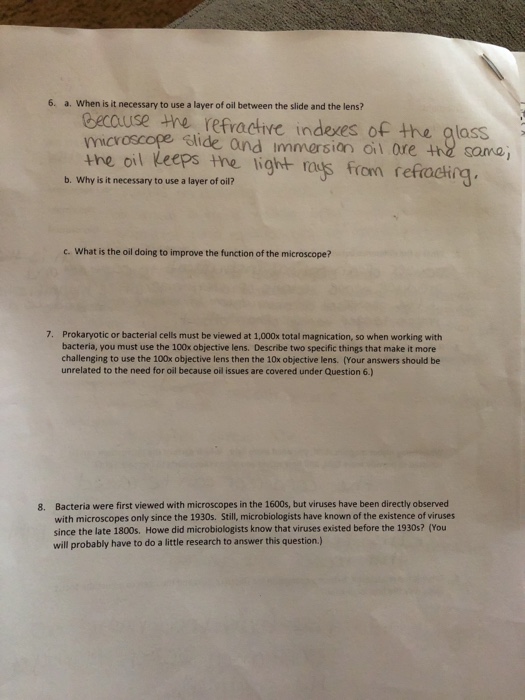There were epidemics of poliomyelitis that were only controlled following the development of a vaccine in the 1950s. The first commercially available antibacterial was Prontosil a sulfonamide developed by the German biochemist.
Solved 6 A When Is It Necessary To Use A Layer Of Oil Chegg Com
If someone were to wave an antimicrobial wand and eliminate all bacterial and archaeal life on the planet what would happen Gilbert.

. For many viruses to penetrate the cell membrane and complete their replication inside the. Although Louis Pasteur and Edward Jenner developed the first vaccines to protect against viral infections they did not know that viruses existed. Bacteria were first viewed with microscopes in the 1600s.
Because they discovered that particles smaller than bacteria could cause disease They used special filters to remove bacteria from tissues that were infected. Alexander Fleming discovered the first antibiotic penicillin. The nature of viruses remained unknown until the invention of the electron microscope in the 1930s when the science of virology gained momentum.
Whilst microbes can cause disease in crops and farm animals they can also help to control pests and weeds to increase crop yields. Without agriculture there would be no food for us to eat. One theory hypothesizes that viruses arose from circular DNA also called a plasmid that can replicate independently and move between cells transferring genetic information from one organism to.
How did microbiologists know viruses existed before the 1930s even if they couldnt see them. However it was only in 1932-1933 that the English scientists Wilson Smith 1897-1965 Sir Christopher Andrewes 1896-1988 and Sir Patrick Laidlaw 1881-1940 working at the Medical Research Council at Mill Hill first isolated the influenza A virus from nasal secretions of infected patients thereby demonstrating the intranasal human transmission of this virus 19 20. Viruses are the smallest of all the microbes.
The Greek physician Hippocrates 460370 BC is considered the father of Western medicine. While most biological diversity can be. The first evidence of the existence of viruses came from experiments with filters that had pores small.
Still microbiologists have known of the existence of viruses since the late 1800s. Unless of course all bacteria disappeared from the planet. Nearly all forms of lifefrom bacteria and archaea to eukaryotes such as plants animals and fungihave viruses that infect them.
The first clear direct photographs of tobacco mosaic virus would not come until 1941 with the invention of powerful electron transmission microscopes which revealed the pathogens skinny. However it took over a decade before penicillin was introduced as a treatment for bacterial infections. They vary in their structure their replication methods and in their target hosts.
In the 20th century many diseases both old and new were found to be caused by viruses. Viruses could not seen until the electron microscope was invented in 1932. Unlike many of his.
Viral Evolution Morphology and Classification. A n _____ is an individual virus particle outside a host cell that consists of a nucleic acid core an outer protein coating and sometimes an outer envelope. The history of virology the scientific study of viruses and the infections they cause began in the closing years of the 19th century.
His results suggested that viruses could be thought of as living molecules rather than organisms. Some foods have probiotics added - live cultures of bacteria that boost the numbers of good microbes and improve gut health. In 1908 Ellerman and Bang demonstrated that certain types of.
All complete viruses are acellular not composed of cells obligatory parasites composed of small amounts of genetic material genome RNA or DNA never both surrounded by a protein coat. Even before the invention of the microscope some doctors philosophers and scientists made great strides in understanding the invisible forceswhat we now know as microbesthat can cause infection disease and death. In the 1930s Elford developed collodion membranes that could trap the viruses and found that viruses had a size of 1 nano meter.
They are unique because they are only alive and able to multiply inside the cells of other living things. Viruses are diverse entities. Still microbiologists have known of the existence of viruses since the late 1800s.
Brief history of antibiotic development as medicines. In the 1930s Stanley isolated a crystalline proteinaceous preparation from infected tobacco plants that retained the infectious power of TMV. But viruses have been directly observed with microscopes only since the 1930s.
By the 1890s most communicable diseases were assumed to be caused by bacteria and establishing causality required culturing them on artificial media. Describes the discovery of viruses and two hypotheses for the origin of viruses. Before that time the word virus had for many decades been used non-specifically to describe a hypothetical communicable agent without denoting any particular size morphology or physical characteristics.
The cell they multiply in is called the host cell. Bacteria were first viewed with microscopes in the 1600s but viruses have been directly observed with microscopes only since the 1930s. They are said to be so small that 500 million rhinoviruses which cause the common cold could fit on to the head of a pin.
It was not until the development of the electron microscope in the late 1930s that scientists got their first good view of the structure of the tobacco mosaic virus TMV Figure 1 discussed above and other viruses Figure 2.
Solved Bacteria Were First Viewed With Microscopes In The Chegg Com
Miga 120 Years Of Medicine Virology Discovering The Invisible Killers
0 Comments